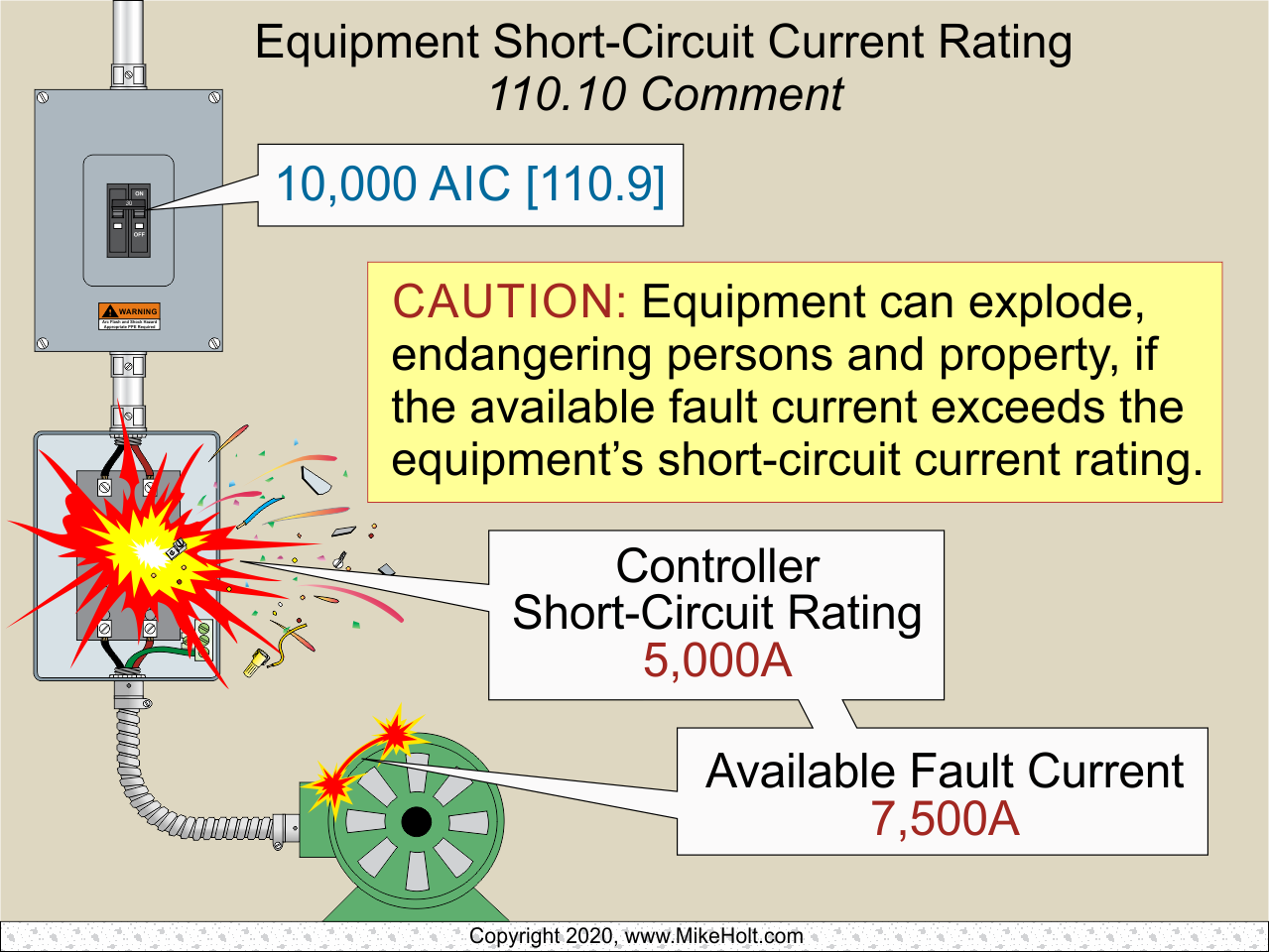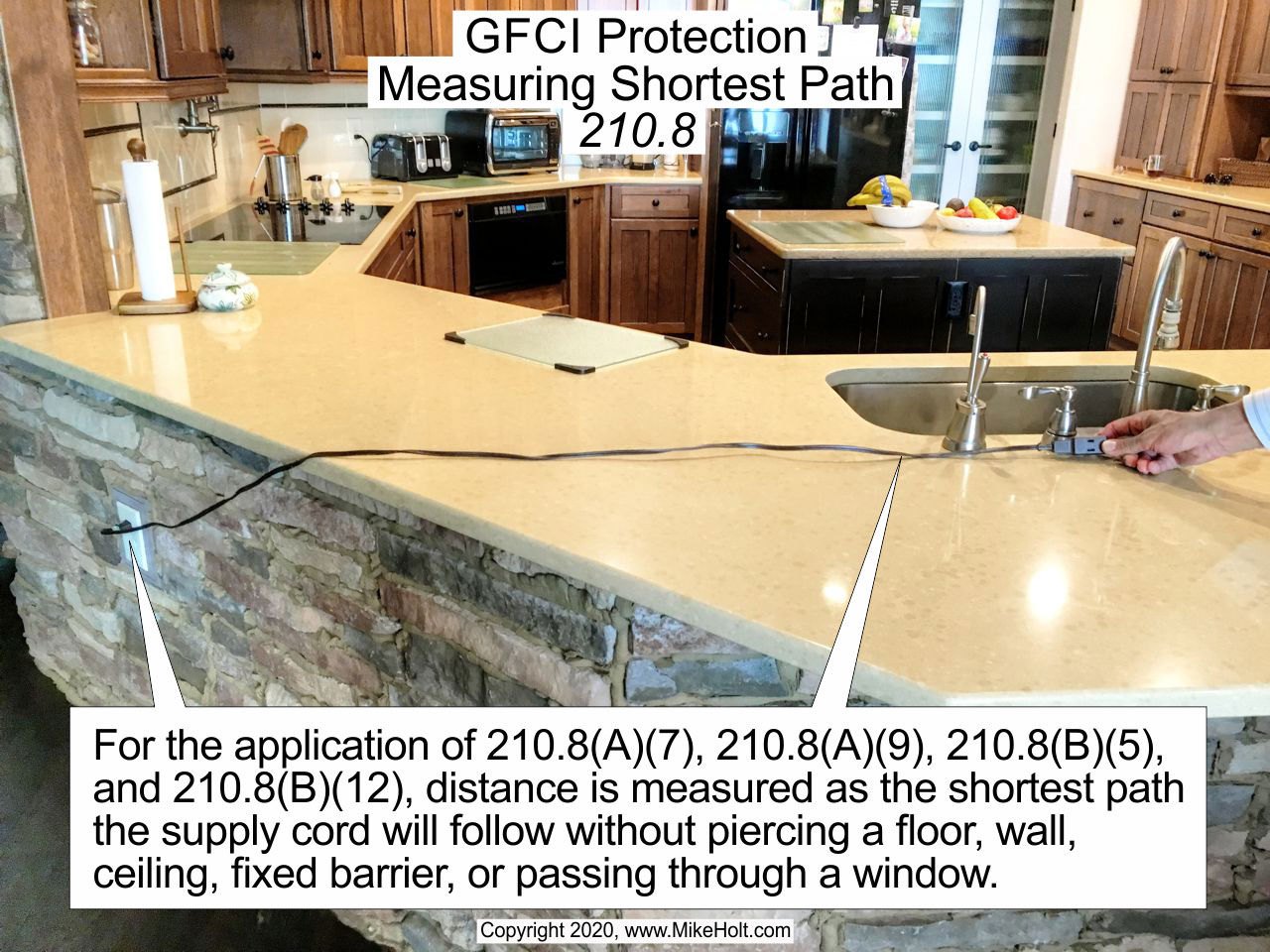|
For EC&M Magazine
By Mike Holt, NEC® Consultant
Note: This article is based on the 2020 NEC.
Do you understand the general requirements for all installations?

Figure 01
|
 |
|
Figure 01
|
For EC&M Magazine
By Mike Holt, NEC® Consultant
Note: This article is based on the 2020 NEC.
Do you know the difference between an AFCI and a GFCI, and know where each is required?
An “Arc-Fault Circuit Interrupter (AFCI) is a device intended to protect against the effects of arc faults by recognizing characteristics unique to arcing and then de-energizing the circuit when it detects an arc fault. It directly protects property by preventing a fire, and thus indirectly protects people.
A “Ground-Fault Circuit Interrupter” (GFCI) is a device intended to protect people from shock by de-energizing a circuit when a current imbalance is 6 mA or higher; it does not trip when the current imbalance is less than 4 mA [Article 100].
Each type of protection is available as a breaker (protects the entire circuit) or a receptacle (can also protect downstream of the receptacle if load side is connected downstream).
Generally, you want to install an AFCI as a breaker but a GFCI as a receptacle. Why?
An AFCI trips due to problems with the branch circuit (generally, conditions inside the wall). The user should call an electrician to determine where the arcing occurred.
A GFCI, on the other hand, trips due to conditions outside the wall. For example, the user plugs in something that poses a shock hazard (which the GFCI detects as exceeding its 6mA trip point). Generally, you don't want the user going to the circuit panel to reset the device.
But evaluate the application before deciding one way or the other. In some cases, the best solution is a dual-function AFCI/GFCI receptacle.
AFCI protection
Where required, AFCI protection must be in a readily accessible location. It must be provided per 210.12(A), (B), (C), and (D):
(A) All 15A or 20A, 120V branch circuits supplying outlets in dwelling unit kitchens, family rooms, dining rooms, living rooms, parlors, libraries, dens, bedrooms, sunrooms, recreation rooms, closets, hallways, laundry areas, or similar areas. AFCI protection is not required for outlets outside or in garages or bathroom areas.
(B) All 15A or 20A, 120V branch circuits supplying outlets in dormitory unit bedrooms, living rooms, hallways, closets, bathrooms, or similar areas.
(C) All 15A or 20A, 120V branch circuits supplying outlets in guest rooms and guest suites of hotels and motels.
(D) Branch circuit extensions or modifications—dwelling units, dormitory units, guest rooms, and guest suites. Where 15A or 20A, 120V branch circuit wiring is modified, replaced, or extended in any of the areas specified in 210.12(A), (B), or (C), it must be AFCI protected.
Ex: AFCI protection is not required for extension wiring that is less than 6 ft long (raceway or cable) if no outlets or devices are added (other than splicing devices). This measurement does not include the conductors inside an enclosure, cabinet, or junction box.
GFCI protection
Where required, GFCI protection must be in a readily accessible location. It must be provided per 210.8(A) through (F).
- Note 2: See 422.5 for GFCI requirements for specific equipment such as automotive vacuum machines, drinking water coolers, high pressure spray washing machines, tire inflation machines provided for public use, and vending machines.
- Note 3: See 555.9 for GFCI requirements for boat hoists.
- Note 4: Additional GFCI requirements for specific circuits and equipment are in Chapters 4, 5, and 6.
When applying 210.8(A)(7), 210.8(A)(9), 210.8(B)(5), and 210.8(B)(12), measure the distance as the shortest path an appliance’s flexible cord will follow without piercing a floor, wall, ceiling, fixed barrier, or passing through a window. Figure 01
Dwelling units
125V through 250V receptacles installed in the following dwelling unit locations must be GFCI protected [210.9(A)]:
(1) Bathroom areas.
(2) Garages of dwelling units and grade level portions of accessory buildings used for storage or work areas of a dwelling unit.
(3) Outdoors, including receptacles under the eaves of roofs.
Ex: GFCI protection is not required for a receptacle dedicated to fixed electric snow melting, deicing, or pipeline and vessel heating equipment if the receptacle is not readily accessible and ground-fault protection of equipment is provided as required by 426.28 and 427.22.
(4) Crawl spaces at or below grade.
(5) Finished and unfinished areas of a basement.
Ex: A receptacle supplying only a permanently installed fire alarm or burglar alarm system is not required to have GFCI protection.
(6) Where serving kitchen countertop surfaces. Receptacles below a countertop for appliances, such as trash compactors or garbage disposals, do not require GFCI protection unless they are 6 ft or less from the top inside edge of the bowl of the sink [210.8(A)(7)].
A refrigerator is not a countertop appliance so GFCI protection is not required, unless the receptacle is 6 ft or less from the top inside edge of the bowl of the kitchen sink [210.8(A)(7)]. Outlets supplying dishwashers require GFCI protection [210.8(D)].
(7) Within 6 ft from the top inside edge of the bowl of a dwelling unit sink.
(8) Boathouse. The Code does not require a receptacle to be installed in a dwelling unit boathouse, but if any are installed they must be GFCI protected.
(9) Within 6 ft of the outside edge of a bathtub or shower stall not installed within a bathroom as defined in Article 100.
(10) Laundry area.
(11) Indoor damp and wet locations.
Additional dwelling unit GFCI requirements
A few more locations have special considerations in 210.8:
(C) Crawl spaces. A lighting outlet is not required for a dwelling unit crawl space unless the space is used for storage or has equipment requiring servicing [210.70(A)(3)].
(D) Specific appliances. Unless GFCI protection is provided per 422.5(B)(3) through (B)(5), the outlets supplying appliances specified in 422.5(A) must have GFCI protection per 422.5(B)(1) or (B)(2). Where the appliance is a vending machine as specified in 422.5(A)(5) and GFCI protection is not provided per 422.5(B)(3) or
(B)(4), the branch circuit supplying the vending machines must have GFCI protection per 422.5(B)(1) or (B)(2).
(E) Equipment Requiring Servicing. A 15A or 20A, 125V receptacle outlet must be installed within 25 ft of heating, air conditioning, and refrigeration equipment [210.63(A)]. Rooftop GFCI receptacles are required to be readily accessible only from the rooftop itself. [210.8(B)(3) Ex.]
(F) Outdoor dwelling unit outlets, other than those for snow-melting equipment covered in 210.8(A)(3) Ex, that are supplied by single-phase branch circuits rated 150 volts or less to ground, 50A or less.
Ex: GFCI protection is not required on lighting outlets other than those covered in 210.8(C).
Other than dwellings
GFCI protection is required for all 125V through 250V receptacles supplied by single-phase branch circuits rated 150V or less to ground, 50A or less, and all receptacles supplied by three-phase branch circuits rated 150V or less to ground, 100A or less, installed in the following locations [210.9(B)]:
(1) Bathroom areas.
(2) Kitchens or areas with a sink and permanent provisions for either food preparation or cooking.
(3) On rooftops. A 15A or 20A, 125V receptacle outlet must be installed within 25 ft of heating, air conditioning, and refrigeration equipment [210.63(A)]. Rooftop GFCI receptacles are required to be readily accessible only from the rooftop itself. [210.8(B)(3) Ex.]
(4) Outdoors.
(5) Within 6 ft from the top inside edge of the bowl of a sink.,
(6) Indoor damp and wet locations.
(7) Locker rooms with showering facilities.
(8) Garages, accessory buildings, service bays, and similar areas.
(10) Unfinished areas of a basement.
(11) Laundry areas.
(12) Within 6 ft of the outside edge of the bathtub or shower stall not installed in a bathroom as defined in Article 100.
Avoiding errors with AFCIs and GFCIs
You cannot install reconditioned AFCIs or GFCIs [210.15]. The NEC does not explicitly bar you from installing used circuit interrupters, but that prohibition is implied by the ban on using reconditioned ones. Besides, why would you want to install a device whose operation and reliability you aren't sure of?
A common misperception with GFCIs is you can't use them on two-wire circuits. In fact, you can; the GFCI senses a difference in current between line and neutral. You don't need to ground the GFCI unless you are installing it in a three-wire (grounded) system.
Because of how a GFCI receptacle functions, it's critical to allow the neutral and line to pass through the device if you intend to protect downstream devices. So no pigtailing the neutral. Ensure the line side conductor and neutral terminate on their respective line side terminals. Ensure the load side conductor and neutral terminate on their respective load side terminals.
Always test the operation of a newly installed GFCI before walking away from it.
|

